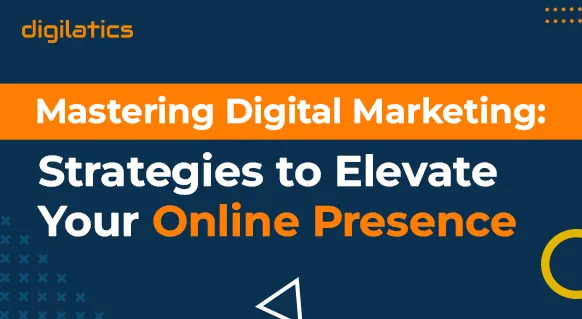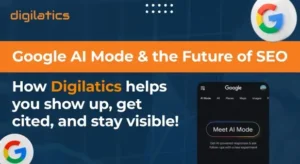Struggling to make digital marketing work for your business? You’re not alone. Nearly 60% of small and medium-sized businesses lack a digital marketing strategy and struggle to track their campaign performance. Simply having a website or social media presence isn’t enough anymore. Brands without a clear digital marketing roadmap risk being lost in the noise.
This guide covers the essential elements of a high-performing digital marketing strategy, from understanding your audience to leveraging SEO, content marketing, and the latest industry trends. Ready to build a digital strategy that actually works and drives real growth? Let’s dive in and see how digital marketing helps to grow your business.
Understanding Your Audience
To begin with, understanding your target audience is the most crucial aspect of any digital marketing plan. It is the prerequisite for successful advertising campaigns and helps create compelling messages, select the right advertising platforms, and create content that resonates and drives customer engagement.
"The better you understand your audience, the stronger your connections, engagement, and conversions." —Emily Clark, Customer Success Manager, Digilatics.
Why Understanding The Audience Is Essential For A Digital Marketing Strategy
Understanding your audience can mean the difference between success and failure in digital marketing. Understanding your audience helps with your digital marketing strategy in two major ways:
Tailored Messaging
Understanding the audience’s emotional experiences is crucial to addressing their needs and concerns. A message that considers the audience’s pain points and how it can alleviate them resonates with its intended audience, helping to convert visitors into customers.
Platform Selection
Every audience behaves uniquely regarding digital platforms. The young generation prefers using TikTok and Instagram, but professional audiences stay primarily on LinkedIn. You should know your target audience’s preferences and choose the platform where they are most active.
The Role Of Buyer Personas
Creating buyer personas stands at the center of audience understanding for marketing purposes. These detailed customer profiles serve as a foundation for messaging, offers, and marketing channels.
Buyer Persona Components
- General Information: Customer age, gender, demographics, income level, and location.
- Psychographics: Values, interests, lifestyle.
- Pain Points: Typical issues or obstacles they face, which you can resolve.
- Decision-Making Factors: What triggers them to buy?
Your marketing becomes more precise when you create different customer personas and target them with personalized messages.
Website Design And User Interface (UI)
Today, businesses rely heavily on their websites to advance their digital marketing goals. Your brand gets its virtual storefront through a website. It influences the brand’s functionality and viability and sets your digital marketing direction.
The Impact Of Website Design & User Interface On Digital Marketing
Your website functions as much more than a showcase of your products or services. Visitors form their opinions and make decisions based on how a website looks and functions. They tend to leave your site when it offers little user-friendliness, insufficient information, and fails to provide engaging content, leading to conversion losses. A website’s excellent design supports your digital marketing strategy in the following ways:
UX Design: Every Experience Counts
Your website’s UX design should provide users an easy-to-use, smooth journey. They should have an uninterrupted experience browsing product information, checking services, and making purchases. Your website should also provide easy navigation at every level and at all times. A lack of quality user experience causes users to leave the site, thus making your marketing campaigns useless.
Mobile-Friendliness: A Necessary Requirement
The rapidly growing mobile traffic demands that every website be optimized for mobile phones. More than 60 percent of people worldwide access websites from mobile devices. Your website requires mobile optimization to create optimal user experiences and to benefit search engine optimization (SEO) initiatives.
Every mobile-friendly website ranks better on Google’s search results due to its algorithm preference. Ignoring this aspect could decrease your search rankings and your website’s online visibility.
The key to great user experience is having a website that automatically adjusts its appearance for desktop computers/laptops and mobile devices.
Core Components Of A Successful Digital Marketing Strategy
To build an effective digital marketing strategy, businesses need to adopt suitable tools and techniques that support their unique business goals. These critical elements must be included in your strategy development. Let’s look at them below.
Search Engine Optimization (SEO)
SEO helps you rank higher organically on search engine results pages(SERPs) and brings more traffic to your website. A search engine optimization strategy contains features that combine on-page elements, including keyword optimization and off-page aspects focused on link building.
SEO Strategies
- Keyword Research: Identifying the most relevant and high-traffic keywords for your business.
- On-Page Optimization: Optimize your content, meta descriptions, headers, and images.
- Technical SEO: Improve website speed, mobile-friendliness, and crawlability.
- Link Building: To raise domain authority, you should build authoritative backlinks.
Content Marketing
A digital marketing plan requires content marketing for businesses to achieve authority, trust, and audience engagement.
Content Marketing Strategies
- Blogs & Articles: Regularly creating high-quality and informative articles about customer-specific issues increases your content value.
- Video Marketing: Produce videos showcasing product reviews, tutorials, user experience, and behind-the-scenes footage and upload them on forums like YouTube and other social media.
- Infographics & Case Studies: Ordinary users find infographics and case studies easy because they simplify complicated subjects while maintaining user engagement.
Social Media Marketing
Facebook, Instagram, LinkedIn, and TikTok maintain a combined user base of billions and provide a golden opportunity for social media marketing to reach customers.
Social Media Marketing Strategies
- Platform-Specific Content: Tailor your messaging to each platform’s unique requirements and audience.
- Social Media Interaction: Respond to users and share user-generated content while developing interactive exchanges.
- Paid Advertising: Use highly targeted ads to boost brand exposure and conversions.
Email Marketing
Email marketing continues to be a key tool for lead development and customer relationship management. Customers remain interested when businesses provide content that aligns with their needs.
Email Marketing Strategies
- Segmentation: Divide your email contacts according to customer characteristics such as demographics and profile type.
- A/B Testing: Conduct A/B Testing to improve email subject lines, combined with better content and clear CTAs, for better engagement results.
- Automated Workflows: Follow predefined email sequences that guide leads from the beginning to the end of the sales funnel.
Pay-Per-Click Advertising (PPC)
Businesses can quickly reach their target audience using PPC, an effective advertising technique. Three important advertising platforms are Google Ads, Facebook Ads, and LinkedIn Ads, which permit highly targeted ad campaigns.
PPC Strategies
- Keyword Targeting: Your PPC strategy should target high-intent keywords representing the criterion that your target audience utilizes for their searches.
- Retargeting: Your business should utilize retargeting ads to bring back visitors who spent time on your website without ordering anything or completing their orders.
- Bid Management: Regular updating of bid levels provides cost efficiency for ad expenditure.
Conversion Rate Optimization (CRO)
Simply getting visitors is not enough to start generating customers because your focus should be on conversions. The primary goal of CRO lies in improving website layout, user interface, and content quality while optimizing conversion metrics.
CRO Strategies
- A/B Testing: Use A/B testing methods to try different combinations of headlines, CTAs, and alternative landing page designs.
- Clear CTAs: Your CTAs must feature direct action phrases, which will motivate users to convert right away.
- Trust Signals: Show positive reviews, testimonials, and certificates as trust signals that boost site credibility.
Data and Analytics in Digital Marketing Strategy
An effective digital marketing strategy depends on data collection. The analysis of key performance indicators (KPIs) helps businesses make data-driven decisions supporting ongoing campaigns. Here are some tools and metrics to track:
Key Metrics And KPIs
- Traffic: Website visitors, session duration, and page views.
- Conversion Rate: The percentage of visitors who take a desired action
- Cost Per Acquisition: The cost of acquiring customers through digital campaigns.
- Return On Investment: The assessment of your digital marketing profitability is known as Return on Investment (ROI).
- Engagement Rate: Interactions on social media platforms, including likes, shares, and comments, form the engagement rate.
Tools
- Google Analytics: It lets you know how users are interacting with your website. This information helps you make better decisions, especially for business expansion.
- Social Media Insights: Built-in analytics on platforms like Facebook, LinkedIn, and Instagram are also helpful.
- HubSpot: The HubSpot application helps users check email performance along with lead management processes.
Important Google Metrics For Digital Marketers
Metric |
Description |
How It Helps Your Digital Marketing Strategy |
|---|---|---|
|
Traffic |
Shows where visitors are coming from (search engines, social media, referrals). |
Determine which channels are most effective for driving traffic. |
|
Bounce Rate |
The percentage of visitors who leave after viewing only one page. |
Indicates whether your content or user experience needs improvement. |
|
User Behavior |
Tracks how users interact with your site (pages viewed, session duration). |
Provides insights on content performance and areas for improvement. |
|
Conversion Rate |
Percentage of visitors who take a desired action (buy, sign-up, etc.). |
Measures how well your site is converting visitors into customers. |
|
Demographics |
Data about your visitors’ age, location, interests, etc. |
Helps in refining your buyer personas and audience targeting. |
Modern Trends Shaping Digital Marketing In 2025
Digital marketing is constantly evolving. Organizations that want to remain competitive must follow contemporary industry trends that change with time. Here’s a look at the present-day trends in shaping the digital marketing industry.
Interactive Content: Engaging Users In Real Time
Interactive content is an essential digital marketing tool for modern strategies because it includes features such as chatbots, quizzes, and polls. It encourages users to interact and participate rather than only reading information.
Webpages and social media platforms use chatbots as standard features of their interfaces. Users receive instantaneous help through these tools, which also answer questions and support purchasing activities. Brands can provide round-the-clock customer support through AI chatbots, which do not require human labor.
Example

Podcasting: Say Your Heart Out
Podcasting has maintained its rising trend among consumers. In 2019, 32% of Americans listened to podcasts; that number jumped to 47% in 2024. Companies employ podcasts to construct authority while presenting captivating stories to build stronger relations with their audience. Through podcasting, businesses can generate valuable content through personal and long-form content formats.
Example

Account-Based Marketing (ABM): Personalizing B2B Efforts
Account-Based Marketing (ABM) uses customized marketing endeavors that target valuable individual accounts as its primary approach. Through ABM, companies can send highly customized promotional campaigns to key decision-makers within their targeted accounts.
Example

Using Remarketing And Retargeting To Welcome Back Customers
Retargeting and remarketing strategies are powerful ways to reach old customers and prospects who previously contacted your brand but failed to become your customers. Retargeting shows your marketing content to those who previously visited your webpage, whereas remarketing utilizes follow-up emails to reactivate potential customers.
Example

Omnichannel Marketing
The omnichannel marketing model guarantees customers a smooth experience no matter what platform they use to connect with you. Customers must experience a uniform, integrated, and consistent experience, enabling them to transition effortlessly from one platform to another.
Example

Influencer Marketing
Your target audience grows through influencer marketing by utilizing industry authorities, known as influencers, to bring in new prospects who will convert. The collaboration with influencers engenders audience trust while tapping into a new customer pool.
Example

Coca-Cola has actively leveraged influencer marketing to expand its reach and engagement. One notable example is its collaboration with TikTok influencers for the #ShareTheMagic challenge, where content creators encouraged users to share their joyful Coke moments through short-form videos.
Additionally, Coca-Cola has worked with YouTube creators and Instagram influencers, such as lifestyle and food bloggers, to promote campaigns like “Taste the Feeling” and “Coke with Meals,” featuring the drink as a key part of social and dining experiences.
Real-Life Case Studies: How Big Brands Excel In Digital Marketing
Let’s look at examples of some companies that have successfully used digital marketing strategies to further their business and consolidate their market shares.
Case Study 1: Nike

Nike prioritizes personalized customer experience as the foundation of its digital marketing plan. It provides customized fitness programs and discount offers and connects users with an athletes’ community via their mobile application.
Through social media platforms, influencer marketing initiatives, and content marketing, Nike secured its position as one of the leading companies successfully leveraging digital marketing.
Small businesses can apply this strategy by using AI-driven recommendations and interactive mobile apps to enhance user engagement.
Case Study 2: Starbucks

The digital loyalty programs at Starbucks have resulted in significant revenue growth. The mobile application provides customers with three essential features: order-ahead service, reward accumulation, and personalized discount offers.
Starbucks actively communicates with customers through social media combined with email campaigns to create sustained customer relationships.
What can you learn from Starbucks to boost engagement and earn repeat sales?
Create loyalty programs, offer mobile ordering, and give personalized discounts to attract customers.
Optimize Your Strategy with Leads Insight
A strong digital marketing strategy is only as effective as the insights driving it. That’s where Digilatics’ Leads Insight comes in.
With real-time lead tracking and performance analytics, our AI-powered lead management helps businesses understand where their budget is going, what’s working, and where to optimize. You get clear, actionable data that allows you to refine your digital marketing efforts for maximum ROI.
- Track Every Lead: Get insights into how leads are generated and where they drop off.
- Optimize Your Budget: See which channels deliver results and reallocate spending accordingly.
- Enhance Conversions: Identify gaps in your funnel and improve targeting strategies.
Want to see how it works? Check out How Digilatics’ Leads Insights can take your digital marketing strategy to the next level.
Final Thoughts
A well-crafted digital marketing strategy is more than just running ads or posting on social media, it’s about understanding your audience, leveraging the right tools, and optimizing continuously. By using data-driven insights, businesses can make informed decisions, improve engagement, and drive sustainable growth. At Digilatics, we help brands cut through the noise with robust marketing solutions.








